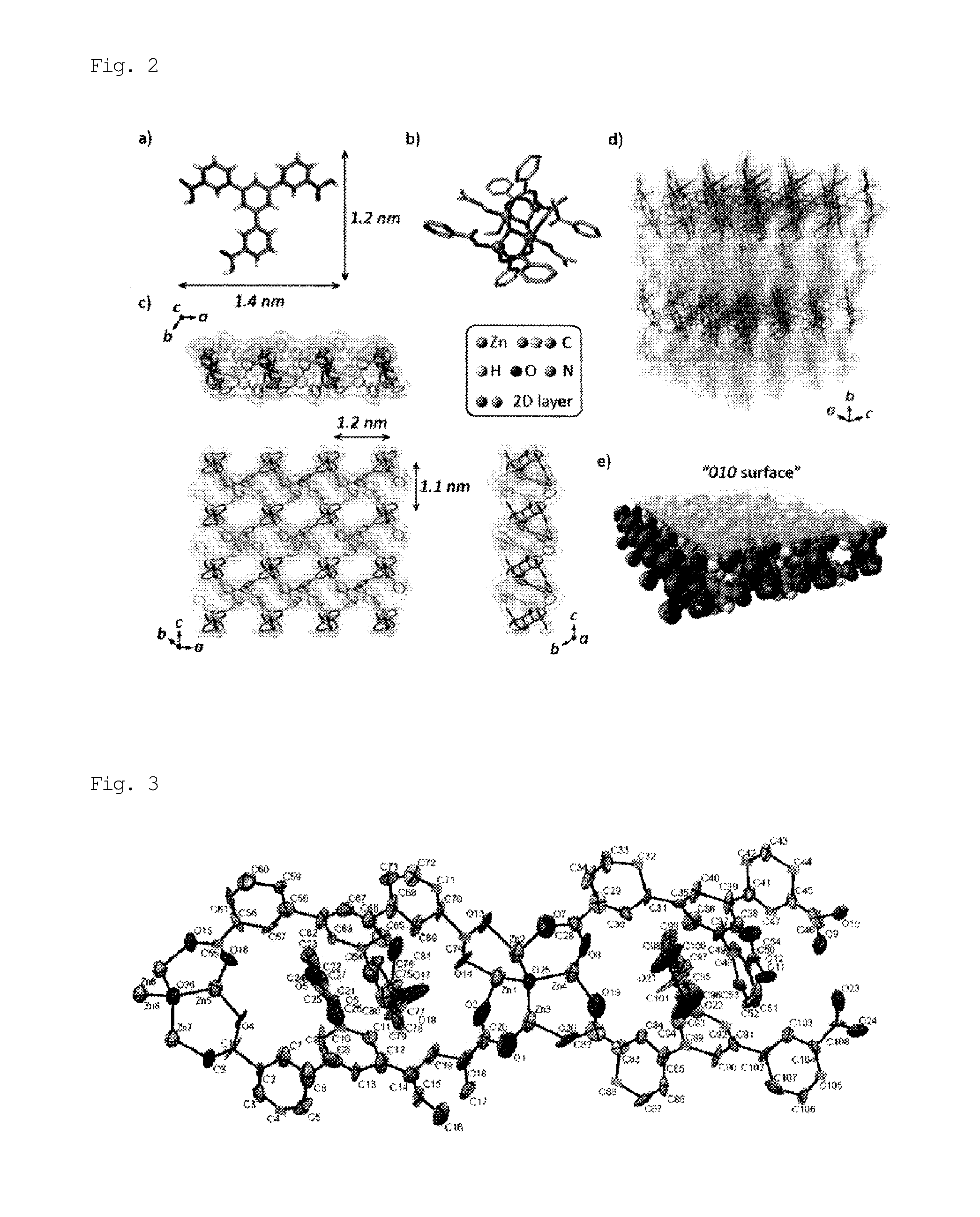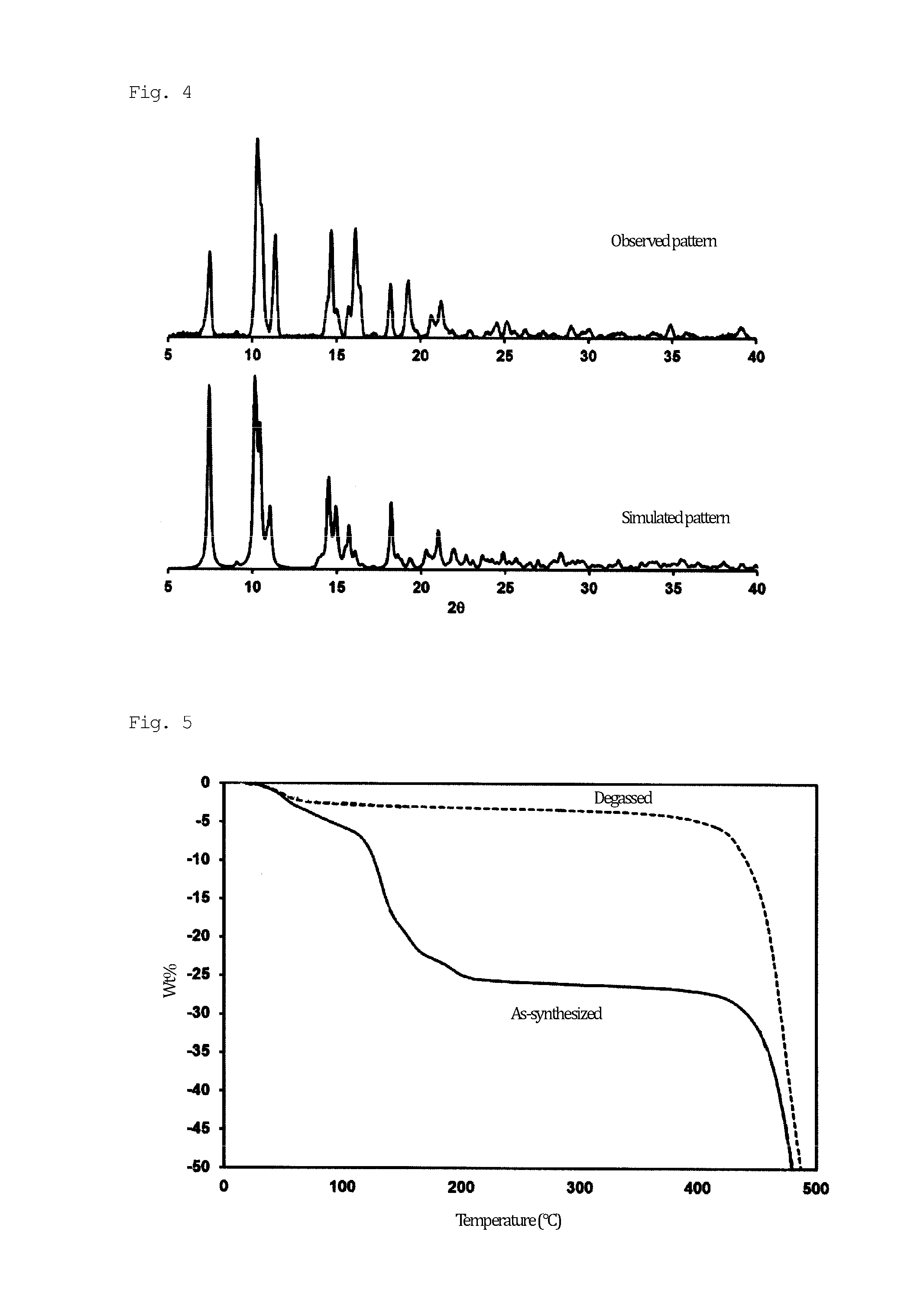Porous coordination polymer and application therefor
a technology of porous coordination and polymer, which is applied in the field of porous coordination polymers, can solve the problems that many porous coordination polymers reported to date have limited practical applicability
- Summary
- Abstract
- Description
- Claims
- Application Information
AI Technical Summary
Benefits of technology
Problems solved by technology
Method used
Image
Examples
example 1
[0096
[0097]A solid mixture of H3BTMB (11 mg, 0.025 mmol) and Zn(NO3)2.4H2O (13 mg, 0.05 mmol) was dissolved in a mixed solution of DMF / MeOH / H2O (0.5 mL / 0.25 mL / 0.25 mL) in a 2-mL glass medicine bottle. To the reaction mixture, 20 μL of NaOH (0.01 M) was added as a deprotonation agent. The initial pH was 6.0. The entire reaction mixture was heated in a temperature-controllable oven from room temperature to 100° C. over 4 hours, and then heated at 100° C. for 48 hours. The oven was cooled from 100° C. to 30° C. over 6 hours. The resulting product, which contained uniform colorless flake-shaped crystals, was washed with MeOH, isolated, and air-dried. The actual amount was 15 mg, and the yield per mole of H3BTMB was 74%. The following single crystal X-ray diffraction etc., showed that single crystals of PCP (1) as synthesized had a structure of [Zn4(μ3-OH)2(BTMB)2(DMF)3(MeOH)].(DMF)2(H2O)2(MeOH) (FIGS. 1 and 2). FIG. 1 shows an ORTEP diagram, in which hydrogen atoms were omitted for cla...
example 3 (
[0106Measurement of adsorption isotherms)
[0107]In order to clarify the water adsorption capacity of the degassed PCP (1a), an adsorption isotherm experiment was conducted at 298 K. FIG. 7 shows the results. PCP (1a) showed unusual adsorption behavior, with two steps at 0.27 kPa and 2.3 kPa in the adsorption isotherm, and no steps in the desorption isotherm. This phenomenon is completely different from other superhydrophobic PCPs. The results of the water adsorption isotherm of PCP (1a) indicate that interior pore surfaces were not hydrophobic but were hydrophilic, and that only the exterior crystal surface exhibited superhydrophobicity. This phenomenon suggested that the superhydrophobicity of PCP (1a) originated from surface structural roughness rather than from chemical features of the surface. As was different from bulk water, water in the form of gas was easily adsorbed into the pores of PCP (1a).
[0108]FIG. 8 shows the adsorption isotherms for CO2 and N2. The adsorption isotherm...
example 4 (
[0111Adsorption experiment of organic solvents, etc.)
[0112]Using the degassed PCP (1a), which had superhydrophobicity and porosity, an experiment was performed to remove organic solvents or oil from the water surface. In order to facilitate the operation, a pellet disk (area: approximately 2.2 cm2) was produced by applying a pressure of 4 to 6 MPa to the degassed PCP (1a) powder. The organic solvents or oil used were toluene, benzene, cyclohexane, and olive oil, and they were colored blue with Oil Blue 35 so as to differentiate them from colorless water. The colored toluene was added dropwise on the water surface, and the pellet disk was dropped in the center of the toluene on the water surface. As a result, the pellet disk adsorbed the toluene. Then, the pellet disk adsorbing the toluene was taken out, thereby separating the toluene from water. The same results as toluene were obtained when benzene or olive oil was used in place of toluene. This revealed that the pellet disk of PCP...
PUM
| Property | Measurement | Unit |
|---|---|---|
| contact angle | aaaaa | aaaaa |
| contact angle | aaaaa | aaaaa |
| molar concentration | aaaaa | aaaaa |
Abstract
Description
Claims
Application Information
 Login to View More
Login to View More - R&D
- Intellectual Property
- Life Sciences
- Materials
- Tech Scout
- Unparalleled Data Quality
- Higher Quality Content
- 60% Fewer Hallucinations
Browse by: Latest US Patents, China's latest patents, Technical Efficacy Thesaurus, Application Domain, Technology Topic, Popular Technical Reports.
© 2025 PatSnap. All rights reserved.Legal|Privacy policy|Modern Slavery Act Transparency Statement|Sitemap|About US| Contact US: help@patsnap.com



